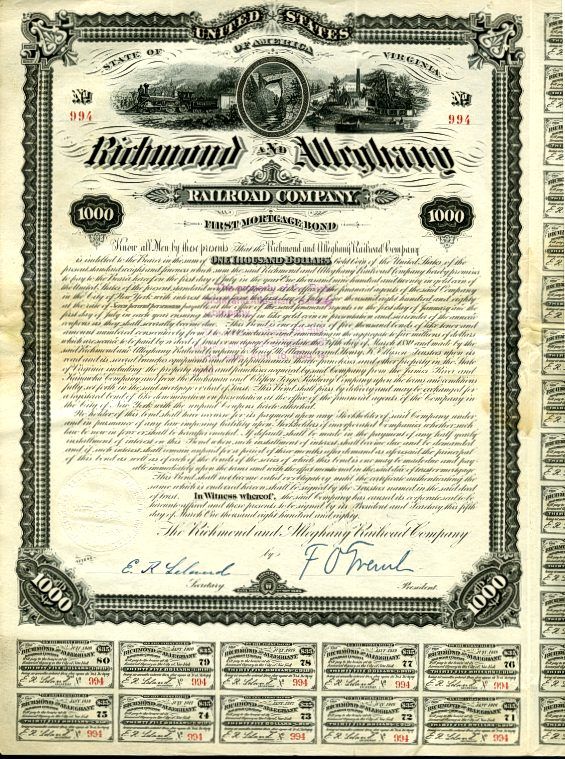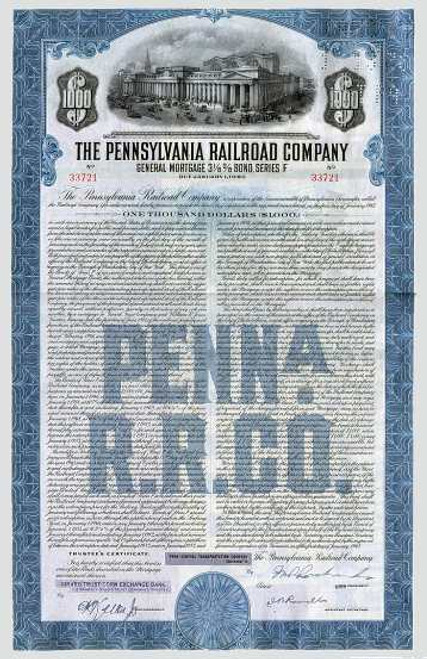Beautifully engraved uncancelled First Mortgage $1000 bond certificate payable in Gold Coin from the Richmond and Alleghany Railroad Company issued in 1880. This historic document was printed by the American Banknote Company and has an ornate border around it with a vignette of a train, Natural Bridge in oval, canal boat at mine,. This item has the signatures of the Company's President, Francis O. French and Secretary, Eugene R. Leland. 63 unused coupons attached on bottom and right side not shown in scan due to size. Light toning. 
Certificate The Richmond and Alleghany Railroad was built along the alignment and the tow path of the James River and Kanawha Canal. The Canal extended 140 miles from Richmond through Lynchburg to Buchanan. The R&A RR was chartered in 1878, replacing both the Canal and earlier railroad attempts in this location. It was completed to Clifton Forge in 1881.The C&O purchased the R&A in 1890. This route provided the C&O with a water level "conveyer belt" route for coal and goods between West Virginia and Newport News. Long a dream of early Virginians such as George Washington, the canal was never completed as envisioned to link the James and Ohio Rivers. Beginning in the 1830s, railroads overtook canals as a preferred technology for transportation in Virginia. The canal was conveyed to the new railroad company by a deed dated March 4, 1880. Railroad construction workers promptly started laying tracks on the towpath. Led by Major James H. Dooley of Richmond, the new railroad offered a water-level route from the Appalachian Mountains just east of West Virginia near Jackson's River Station (now Clifton Forge) through the Blue Ridge Mountains at Balcony Falls to Richmond. In 1888 the railroad was leased, and later purchased, by Collis P. Huntington's Chesapeake and Ohio Railway (merger with C&O occurred in 1889 [3]). Major Dooley built a mansion on an estate west of Richmond (just east of the current Boulevard Bridge) overlooking the railroad. He and his wife Sallie became benefactors for many philanthropic causes around Richmond, and their estate in Richmond became Maymont. Today, the former Richmond and Alleghany Railroad is a major route of CSX Transportation. It forms the Rivanna and James River subdivisions. The eastern terminus is Richmond's Main Street Station. It meets the former Virginia Central Railroad (now operated by the Buckingham Branch Railroad, a short-line operator) at Rivanna Junction. RICHMOND AND ALLEGHANY RAILROAD 1882 Line of Road.--Richmond, Va., to Williamson's, Va 230.31 miles. Lexington Branch: Balcony Falls (174| m. w. Richmond) to Lexington.. 19.38" Leased: Henrico RR.: Lorraine to Hungary Station, Va 11.00" Total length of line operated 260.69 miles. Sidings and other tracks, 12.5 miles. Gauge, 4 ft. 9 in. Rail (all 6teel), 56 lbs. Telegraph line, 250.5 miles; telephone line, 12 miles; iron bridging (5), 2,713^ ft. Chartered February 27, 1879. The R. & A. RR. Co. acquired the properties, works, and franchises of the James River and Kanawha Canal Co., and the Buchanan and Clifton Forge Railway Co., at a cost in stock and cash of (including liens, $1,537,381.42), $6,389,511.93; thus securing right of way for its railroad lines, basins, and docks in Richmond, and other property. The company also acquired rights of way needed by improved location at a further cost, in cash, of $199,097.83. Total cost for basis of operations, $6,588,609.76. The main stem, Richmond to Williamson's, was completed September 12, 1881, and the branch to Lexington, October 14, 1881. The road was formally opened October 15, 1881. Rolling Stock.--Locomotive engines, 21. Car stock--passenger, 17; baggage, 10; caboose, 8; freight (box, 187; flat, 255), 442; coal and ore, 21; stock, 25--total cars, 523. Operations for year ending September 80, 1881 (average 122.83 miles).--Total engine service, 244.032 miles. Car service--passenger, 268,178; freight, 561,780-- total, 829,958 miles; total (including material not charged), 1,252,928 miles. Passengers carried, 75,852; one mile, 2,461,291; average rate, 2.25 cents. Freight moved, 62,289.94; one mile, 2,493,031 tons; average rate, 3.64 cents. Net earnings (11.77 per cent.), $18,337.73. Add--water rents, $9,062.45; canal earnings, $12,468.52; dockage, $47,533.33; and Bremo (66 m. w. Richmond) Ferry, $186.24--total revenue, $87,588.27. Payments: Canal and water-power, $22,728.97; Richmond docks, $9,666.84; Bremo Ferry, $212.31; and general expenses, $60,983.07 --total disbursements, $93,591.19. Balance charged to construction, $6,002.92. For the six months ending March 31, 1882, the earnings from passenger were $50,677.74; freight, $128,517.91; other sources, $41,289.18--total, $220,484.83. Operating expenses, $174,901.39. Net earnings, $45,583.44. General Balance Sheet, March 31, 1882. Capital Stock $5,000,000 00 Bonded Debt 5,809,000 00 Franchise and Right of Way $5,878,931 30 Cost of Road 5,281,836 95 Richmond Docks 1,000,843 91 Second Mortgage Subscription 1,850,000 00 J. R. & K. Co. and B. C. F. Ry. Liens. 1,403,853 27 Principal of Car Trusts 354,000 00 Bills Payable 464,709 60 March Liabilities 108,741 15 Profit and Loss 2,405 88 Total Liabilities 814,386,109 14 Total Assets $14,386,109 14 Bonded debt: 1st mtg. bonds, .authorized $5,000,000, issued $4,925,000. Jan. & July. 2d mortgage bonds "4,000,000." 813,000. May & Nov. $5,809,000. Directors (elected December 13, 1881).--Decatur Axtell, William H. Barnum, Calvin S. Brice, Dan. P. Eells, F. O. French, J. Lee Humfreville, Lawrence Myers, John J. McCook, William L. Scott, Samuel Shethar, John W. Simpson, Samuel Thomas, Charles E. Wortham. Francis O. French, President New York, N. Y. Decatur Axtell, Vice-President Richmond, Va. Principal Office And Address Richmond, Va. General Office No. 2 Wall Street, New York.
Francis Ormond French, a Resident Member from 1883, was born in Chester, New Hampshire, September 12, 1837, and died in Tuxedo, New York, February 26, 1893. He was a son of Benjamin Brown and Betsey Smith (Richardson) French, and she was a daughter of Chief Justice William Merchant Richardson, of Chester, New Hampshire. His grandfather was Hon. Daniel French. He was descended from Edward1 French, of Salisbury, Massachusetts, through Joseph2, of Ipswich, Joseph', of Salisbury, Joseph4, Daniel5, Gould", of Epping, New Hampshire, Daniel7, and Benjamin Brown8, his father. He prepared for college at Phillips Exeter Academy, and entered the Sophomore class at Harvard in 1854, where he was graduated with honors in 1857. He was admitted to the Bar in 1860. In 1862 he was appointed deputy naval officer of customs at Boston, and in 1863 was appointed deputy collector of the same port. He resigned in 1865, to enter the banking firm of Samuel A. Way, of Boston. In 1870 he went to New York, to enter the firm of Jay Cook and Company. After the Cook failure, he represented the London firms of McCullough and Company, and Melville, Evans, and Company, in New York. In 1874 he, with others, secured the control of the First National Bank of New York, and engineered the funding operations of United States Loans. In 1880 he retired from business, but in 1888 accepted the presidency of the Manhattan Trust Company. He was married, in 1861, to Ellen, daughter of Hon. Amos Tuck, of Exeter. By this marriage there were three children: Elizabeth, who married Colonel the Hon. Herbert Francis Eaton, of the Grenadier Guards in England; Amos, who was connected with the Manhattan Trust Company; and Elsie, who resided with her mother in Tuxedo, New York. History from Wikipedia and OldCompany.com (old stock certificate research service)

Certificate
Francis Ormond French, a Resident Member from 1883, was born in Chester, New Hampshire, September 12, 1837, and died in Tuxedo, New York, February 26, 1893. He was a son of Benjamin Brown and Betsey Smith (Richardson) French, and she was a daughter of Chief Justice William Merchant Richardson, of Chester, New Hampshire. His grandfather was Hon. Daniel French. He was descended from Edward1 French, of Salisbury, Massachusetts, through Joseph2, of Ipswich, Joseph', of Salisbury, Joseph4, Daniel5, Gould", of Epping, New Hampshire, Daniel7, and Benjamin Brown8, his father. He prepared for college at Phillips Exeter Academy, and entered the Sophomore class at Harvard in 1854, where he was graduated with honors in 1857. He was admitted to the Bar in 1860. In 1862 he was appointed deputy naval officer of customs at Boston, and in 1863 was appointed deputy collector of the same port. He resigned in 1865, to enter the banking firm of Samuel A. Way, of Boston. In 1870 he went to New York, to enter the firm of Jay Cook and Company. After the Cook failure, he represented the London firms of McCullough and Company, and Melville, Evans, and Company, in New York. In 1874 he, with others, secured the control of the First National Bank of New York, and engineered the funding operations of United States Loans. In 1880 he retired from business, but in 1888 accepted the presidency of the Manhattan Trust Company. He was married, in 1861, to Ellen, daughter of Hon. Amos Tuck, of Exeter. By this marriage there were three children: Elizabeth, who married Colonel the Hon. Herbert Francis Eaton, of the Grenadier Guards in England; Amos, who was connected with the Manhattan Trust Company; and Elsie, who resided with her mother in Tuxedo, New York. History from Wikipedia and OldCompany.com (old stock certificate research service)








